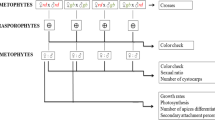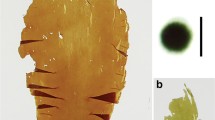Abstract
Species of Gracilaria are some of the most useful algae in the world for the production of agar. As a consequence of its economic importance, the genus has been the subject of many studies worldwide. Color variants of Gracilaria birdiae have been found in the natural population on the Brazilian coast, and they have also been isolated from plants cultivated in laboratory. These findings raised new questions regarding intraspecific variation and the prospects of cultivating such variants for their agar production. Therefore, this work aimed to determine the mode of color inheritance for two G. birdiae strains: a greenish-brown strain (gb) found in a natural population and a green strain (gr) which had arisen as a spontaneous mutation in a red plant cultured in the laboratory. The pigment contents of these strains, as well as the red wild-type (rd), were also characterized. Crosses between female and male plants of the same color (rd, gr, or gb) and between different colors were performed. Crosses between plants of the same color showed tetrasporophytic and gametophytic descendents of the parental color. Recessive nuclear inheritance was found in the greenish-brown strain, and cytoplasmic maternal inheritance was found in the green strain; both had lower phycoerythrin and higher concentrations of allophycocyanin and phycocyanin than the wild-type. Chlorophyll a contents were similar among all strains. Taken together, our results contribute to knowledge about the variability of this important red algae. In addition, since greenish-brown and green strains showed stability of color, both could be selected and tested in experimental sea cultivation to evaluate if mutants have advantageous performance when compared with red strain.




Similar content being viewed by others
References
Apt KE, Grossman AR (1993) Characterization and transcript analysis of the major phycobiliprotein subunit genes from Aglaeothamnion neglectum (Rhodophya). Plant Mol Biol 21:27–38
Bouzon ZL, Miguens F, Oliveira EC (2000) Male gametogenesis in the red algae Gracilaria and Gracilariopsis (Rhodophyta, Gracilariales). Cryptogam Algol 21:33–47
Costa VL, Plastino EM (2001) Histórico de vida de espécimes selvagens e variantes cromáticas de Gracilaria birdiae (Gracilariales, Rhodophyta). Rev Bras Bot 24(suppl):491–500
Egelhoff T, Grossman AR (1983) Cytoplasmic and chloroplast synthesis of phycobilissome polypeptides. Proc Natl Acad Sci USA 80:3339–3343
Ferreira LB, Barufi JB, Plastino EM (2006) Growth of red and green strains of the tropical agarophyte Gracilaria cornea (Gracilariales, Rhodophyta) in laboratory. Rev Bras Bot 29:185–190
Guimarães M, Plastino EM, Destombe C (2003) Green mutant frequency in natural populations of Gracilaria domingensis (Gracilariales, Rhodophyta) from Brazil. Eur J Phycol 38:165–169
Jeffrey SW, Humphrey GF (1975) New spectrophotometric equations for determining chlorophylls a, b, c 1 and c 2 in higher plants, algae and natural phytoplankton. Biochem Physiol Pflanzen 167:191–194
Kain JM, Destombe C (1995) A review of life history, reproduction and phenology of Gracilaria. J Appl Phycol 7:269–281
Kuroiwa T, Uchida H (1996) Organelle division and cytoplasmic inheritance—the origin and basis of the transmission of organelle genomes. Bioscience 46:827–835
Kursar TA, van der Meer J, Alberte RS (1983) Light-harvesting system of the red alga Gracilaria tikvahiae. I. Biochemical analyses if pigment mutations. Plant Physiol 73:353–360
Oliveira EC, Plastino EM (1994) Gracilariaceae. In: Akatsuka I (ed) Biology of economic algae. SPB Academic, The Hague, pp 185–226
Oliveira EC, Alveal K, Anderson R (2000) Mariculture of agar-producing gracilarioid red algae. Rev Fish Sci 8:345–378
Patwary MU, van der Meer JP (1984) Growth experiments on autopolyploids of Gracilaria tikvahiae (Rhodophyceae). Phycologia 23:21–27
Patwary MU, van der Meer JP (1992) Genetic and breeding of cultivated seaweeds. Korean J Phycol 7:281–318
Plastino EM, Costa VL (1999) Ultrastructure of vegetative branches of the red macroalga Gracilaria birdiae (Gracilariales). Acta Microsc 8(suppl):793–794
Plastino EM, Costa VL (2001) Anomalous plastids in a light green strain of the red macroalga Gracilaria sp. (Gracilariales). Acta Microsc 3(Sup. C):315–316
Plastino EM, Guimarães M (2001) Diversidad Intraespecifica. In: Avelã KV, Antezana TJ (eds) Sustentabilidad de la Biodiversidad. Universidad de Concepción, Concepción, pp 19–27
Plastino EM, Oliveira EC (1990) Crossing experiments as an aid to the taxonomic recognition of the agarophytes Gracilaria. In: Oliveira EC, Kautsky N (eds) Cultivation of seaweeds in Latin America. Universidade de São Paulo, São Paulo, pp 127–133
Plastino EM, Oliveira EC (2002) Gracilaria birdiae (Gracilariales, Rhodophyta), a new species from the tropical South American Atlantic with terete frond and deep spermatangial conceptacles. Phycologia 41:389–396
Plastino EM, Guimarães M, Matioli SR, Oliveira EC (1999) Codominant inheritance of polymorphic color colors of Gracilaria domingensis (Gracilariales, Rhodophyta). Gen Mol Biol 22:105–108
Plastino EM, Ursi S, Fujii MT (2004) Color inheritance, pigment characterization, and growth of a rare light green strain of Gracilaria birdiae (Gracilariales, Rhodophyta). Phycol Res 52:45–52
Ramus J, van der Meer JP (1983) A physiological test of the theory of complementary chromatic adaptation. I. Color mutants of a red seaweed. J Phycol 19:86–91
Reith ME, Munholland J (1995) Complete sequence of the Porphyra purpurea chloroplast genome. Plant Mol Biol Report 13:333–335
Rothman MD, Anderson RJ, Boothroyd CJT, Kemp FA, Bolton JJ (2009) The gracilarioids in South Africa: long-term monitoring of a declining resource. J Appl Phycol 21:47–53
Ryan KG, Nelson WA (1991) Comparative study of reproductive development in two species of Gracilaria (Gracilariales, Rhodophyta). I—spermatogenesis. Crypt Bot 2/3:229–233
Santelices B, Correa JA, Meneses I, Aedo D, Varela D (1996) Sporeling coalescence and intraclonal variation in Gracilaria chilensis (Gracilariales, Rhodophyta). J Phycol 32:313–322
Ursi S (2005) Diversidade intraespecífica em Gracilaria birdiae (Gracilariales, Rhodophyta): crescimento, fotossíntese, pigmentos, polissacarídeos e genes da ficoeritrina de linhagens selvagens e variantes. Tese. São Paulo: Universidade de São Paulo
Ursi S, Plastino EM (2001) Crescimento in vitro de linhagens de coloração vermelha e verde clara de Gracilaria sp. (Gracilariales, Rhodophyta) em dois meios de cultura: análise de diferentes estádios reprodutivos. Rev Bras Bot 24:587–594
Ursi S, Pedersén M, Plastino EM, Snoeijs P (2003) Intraspecific variation of photosynthesis, respiration and photoprotective carotenoids in Gracilaria birdiae (Gracilariales, Rhodophyta). Mar Biol 142:997–1007
Ursi S, Guimarães M, Plastino EM (2008) Deleterious effect of TRIS buffer on growth rates and pigment contents of Gracilaria birdiae Plastino & E.C. Oliveira (Gracilariales, Rhodophyta). Acta Bot Bras 22:891–896
van der Meer JP (1977) Genetics of Gracilaria birdiae (Rhodophyceae, Gigartinales). II. The life history and genetic implications of cytokinetic failure during tetraspore formation. Phycologia 16:367–371
van der Meer JP (1978) Genetics of Gracilaria birdiae (Rhodophyceae, Gigartinales). III. Non-mendelian gene transmission. Phycologia 17:314–318
van der Meer JP (1979) Genetics of Gracilaria tikvahiae (Rhodophyceae, Gigartinales). V. Isolation and characterization of mutant strains. Phycologia 18:47–54
van der Meer JP (1981) Genetics of Gracilaria tikvahiae (Rhodophyceae). VII. Further observations and construction of polyploids. Can J Bot 59:787–792
van der Meer JP (1986) Genetics of Gracilaria tikvahiae (Rhodophyceae). XI. Further characterization of a bisexual mutant. J Phycol 22:151–158
van der Meer JP (1987) Marine algal genetics and genomes: using genetic markers in phycological research. Hydrobiologia 151/152:49–56
van der Meer JP (1990) Genetics. In: Cole K, Sheath R (eds) Biology of the red algae. Cambridge University Press, New York, pp 103–121
van der Meer JP, Bird NL (1977) Genetics of Gracilaria birdiae (Rhodophyceae, Gigartinales). I. Mendelian inheritance of two spontaneous green colors. Phycologia 16:159–161
van der Meer JP, Todd ER (1977) Genetics of Gracilaria sp. (Rhodophyceae, Gigartinales). IV. Mitotic recombination and its relationship to mixed phases in the life history. Can J Bot 55:2810–2817
van der Meer JP, Zhang X (1988) Similar unstable mutations in three species of Gracilaria (Rhodophyta). J Phycol 24:198–202
Yokoya NS, Plastino EM, Artel R (2003) Physiological responses and pigment characterization of two colour strains of the carrageenophyte Hypnea musciformis (Rhodophyta). In: Chapman ARO, Anderson RJ, Vreeland VJ, Davison R (eds) Proceedings of the 17th International Seaweed Symposium. Oxford University Press, New York, pp 425–433
Zhang X, van der Meer JP (1987) A study on heterosis in diploid gametophytes of marine red alga Gracilaria tikvahiae. Bot Mar 30:309–314
Zhang X, van der Meer JP (1988) A genetic study Gracilaria sjoestedtii. Can J Bot 66:2022–2026
Acknowledgments
This research was supported by FAPESP (98/11943-1; 00/12801-0; 10/00017-2) and CNPq (132845/98-9; 300148/93-3). The authors acknowledge Rosário Petti for assistance on cultivation and Maria Lucia Kawasaki for reviewing the manuscript.
Author information
Authors and Affiliations
Corresponding author
Rights and permissions
About this article
Cite this article
Costa, V.L., Plastino, E.M. Color inheritance and pigment characterization of red (wild-type), greenish-brown, and green strains of Gracilaria birdiae (Gracilariales, Rhodophyta). J Appl Phycol 23, 599–605 (2011). https://doi.org/10.1007/s10811-010-9642-3
Received:
Revised:
Accepted:
Published:
Issue Date:
DOI: https://doi.org/10.1007/s10811-010-9642-3




